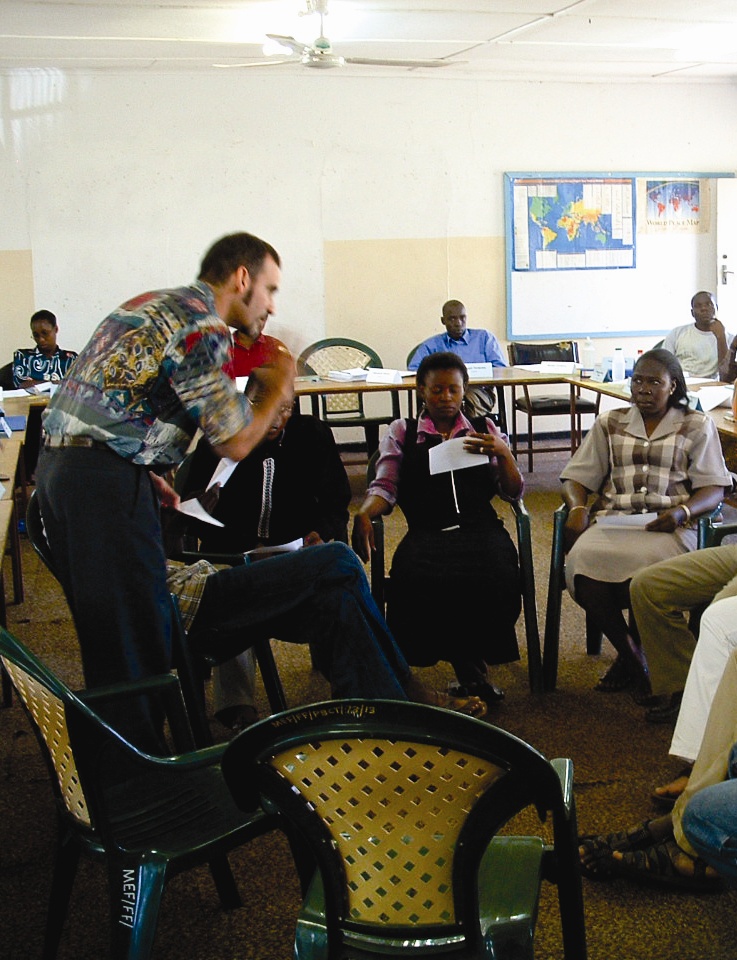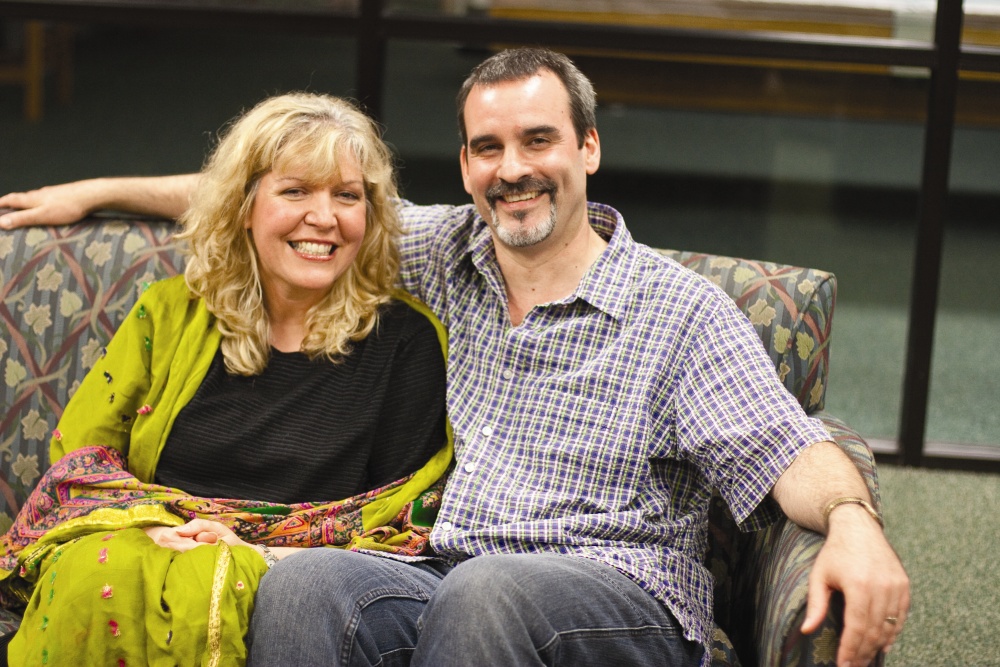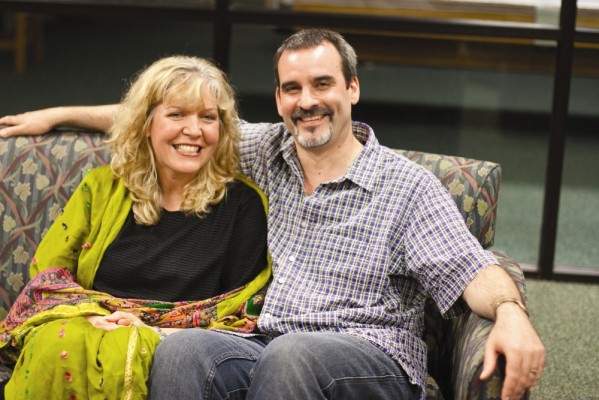
Raised in war-torn Vietnam for his first 11 years, Dr. Carl Stauffer ’85 (MA ’02) experienced few doubts during his formative years as to where he was heading: always towards peace work and practical ministry.
Chapter 1: Vietnam
My parents went to Vietnam in 1957 under what is now called Eastern Mennonite Missions. They were the first Mennonites there, as far as I know. I was born in 1964. Four years later, we lived through the Tet Offensive in Vietnam.
The Tet Offensive was a massive coordinated attack begun January 1968 by the North Vietnamese military on multiple sites in South Vietnam, including Saigon where the Stauffer family was living. By the time it ended in March 1968, tens of thousands of soldiers on both sides were dead, with the heaviest losses sustained by the North Vietnamese.
Fighting came within a half mile of our home. Bullets were falling on our tin roof. A helicopter rained down fire on an adjacent gas station. We were under curfew, but a 13-year-old Vietnamese girl broke it in order to come and help us get out of the part of the city where the fighting was fiercest. She showed us a route through small alleys in a squatter area.
“We were a family of five on a scooter – my brother sitting on the spare tire on the back holding onto my mother who was holding onto Dad. I was on my mother’s lap – I think she was sitting side saddle. My sister was standing in front of my father holding onto the scooter’s handlebar.
“I remember getting under the bed and praying and singing with my parents. To my parents’ credit, I never recall a sense of terror, and neither do my two siblings – somehow they shielded us from the fear of that time.
“My father went out after the Tet Offensive and took pictures. One showed a burnt-out tank close to our home. Another showed a North Vietnamese soldier – they wore all black – who had been killed by mass violence. I recall his feet were tied together and his hands, and he was dragged through the streets while people cheered and threw stuff. He wasn’t given an honorable burial. He was used for mob hatred. I have never forgotten those scenes.
“We left in ’75, three weeks before Saigon was taken over – I guess my parents were worried about what might happen to us children in the ensuing chaos – it is not that they were supporters of the South Vietnamese regime.
“We weren’t sure we could all get out together. We had tickets for one plane but it was canceled and we had to come up with more money for other tickets. Dad didn’t have the cash and was trying to figure out how to get my mother, sister and I out (my brother was already in a boarding school in the Philippines). He had resigned himself to staying back, when Bob Pierce [who first founded World Vision, then Samaritan’s Purse] was in the same line trying to get out. Bob said [to Carl’s father] ‘you look distressed,’ and when he realized why, he pulled out his credit cards and said, ‘You buy whatever you need to get you and your whole family out.’
Carl’s mother, Arlene died in 1985. Then his father, James, married Ruth Yoder, who had been a missionary nurse in Vietnam for six years. Fluent in Vietnamese, James and Ruth continue to interact with the Vietnamese Mennonite Church in northern Virginia, as well as relate to local Vietnamese community members in the Shenandoah Valley.
Chapter 2: South Africa
So when we [Carl and his wife Carolyn ’84] arrived on the scene in South Africa – it was 1994 and we were MCC volunteers – I had not been exposed to a low-scale war situation since Vietnam, not counting the three years as a teenager in the Philippines when the Marcos regime was crumbling and there was plenty of political violence.
“I had a tour of a township with this young soldier with a gun. And I was going through a place where the houses were abandoned, I was picking up empty bullet shells—this was ’94 and I was 29 years old – but the trauma of war came back to me. Not in a way that I couldn’t handle. But I started to feel, and smell, and sense danger in that setting.
“And I had to talk my way through it, saying, ‘You are in South Africa and in a relatively safe zone.’ It was hot — the sun was beating down — and there was a big armored personnel carrier moving up and down the street. This was apartheid South Africa. I could feel the fear of war and the carnage of that time in Vietnam. It was the first time that I felt trauma revisiting me.

A sampling of Carl’s experience
Carl Stauffer, EMU’s newest professor of restorative justice, brings vast cross-cultural experience in conflict transformation and building peace.
After earning an EMU degree in social work (with a minor in Bible and religion), Stauffer spent six years planting an interracial center-city church in Richmond, Virginia. He also was the founding director of Richmond’s Victim-Offender Reconciliation Program.
While living in Johannesburg, South Africa, for 16 years, Carl and Carolyn Stauffer raised daughter Grace and son Christopher (now a junior at EMU), earned a PhD each, and left a rich legacy of accomplishments among churches and nongovernment organizations across the continent.
Just a glimpse at Carolyn, who mainly teaches undergraduates in EMU’s sociology department: She grew up in the Middle East, is fluent in Hebrew, graduated from EMU with a degree in social work, and spent most of her time in South Africa working on organizational and community development and addressing gender-based violence.
Back to Carl, in South Africa he focused on the transition from apartheid-era warfare to post-apartheid efforts at stabilizing that country. He was plugged into various transitional processes, including the peace accords, community-police forums, the Truth and Reconciliation Commission, and local community development structures.
From 2000 to 2009, Carl was Mennonite Central Committee’s Regional Peace Adviser for the Southern Africa region, a role that took him to 20 African countries and 10 other countries in the Caribbean, Middle East, Europe, and the Balkans. He stresses that he consulted this widely only by invitation and that he got good feedback and gentle correctives from a 12-member task force of respected colleagues that he assembled in South Africa to help him make wise decisions.
Carl’s 16 years of intense activity cannot be fairly covered in these pages, so we will focus on five instructive examples, with the caveat that Carl always teamed up with others, usually folks more deeply rooted in a particular context than he was. In short, neither he nor MCC gets, or claims, all the credit.
1. South Africa’s Truth and Reconciliation Commission (TRC) was only the first step in a much longer journey that has yet to be realized, says Carl Stauffer.
Most of us know the TRC because it was one of the first such commissions in the world and certainly the best known, headed by Nobel Peace laureate Bishop Desmond Tutu. Carl says the TRC was well motivated, but their mandate was much too large for their two-year timeframe, so while they did lay the groundwork for national healing, it was only a first stride.
Every Sunday night there was a TRC special report for about two hours on the TV and radio – the nation listened and watched what happened that week. That is when the so-called reconciliation meetings were watched… They were difficult viewing at times. This was partly because the offenders had thought about their complicity for a long, long time, and they frequently had a heartfelt apology to offer that would get their guilt feelings off their chests. But the victims, or their surviving family members, hadn’t to this point been provided with a forum in which to process their feelings. They had been holding their feelings down, and most of them weren’t emotionally prepared for this meeting. It was often a difficult process for them to articulate and vent several decades’ worth of grief in only a several-hour encounter.
2. Sustained and long-term dialogue is crucial for healing and for people and communities to find their own solutions.
The ecumenical NGO that I was affiliated with and three other NGOs were part of a steering committee that pulled together a pilot project to show an alternative way of building community. We chose four magisterial districts that we had worked with in greater Johannesburg and Pretoria. We then identified a community-based organization in each district to partner with us. This partner put forward 10 people to be trained – from youth organizations, legal aid centers, churches and so forth – and so we trained 40 mediators. Then we worked with the courts to refer cases to these mediators. We told the local judges, ‘at least try this,’ especially since the crime situation was desperate in South Africa. The system is really overloaded, bulging. There was a two-year waiting list to get your day in court.
As a general rule, the African magistrates [i.e. those with indigenous roots] were very open to restorative justice, because it made sense to them. We had one judge who would start his day by inviting everyone on the court roster to gather in front of him. He would give them a choice of being seen by him at some point that day for a ruling, or of talking with our mediators (‘they are right here, waiting to speak with you’). At least a third of them chose the mediators, and they got good results. The mediators had been through a five-day training course initially; they then got a three-day refresher course, so eight days in all.
3. Joint artistic and narrative productions are powerful tools for achieving reconciliation.
There were these two commanders, one from the IFP and the other from the ANC [rival political groups], who had been fighting all through the townships after Mandela’s release in 1990. We taught them video skills and asked them to tell their stories on camera and conduct interviews in their respective communities. We asked them to bring their footage back to the Peace Media Center in Cape Town and together come up with one 90-minute video that they could both stomach, that would explain the political violence. They ended up identifying 11 different roots to the conflict, and most of them were the same for both their communities.
What happened between the commanders was so transformational. They reconciled, and they said ‘we need to share this.’ We started to have public viewings for the political parties, women’s groups, youth groups, churches, etc. We broke them into small ‘commissions’ with a mixed composition and we used trained facilitators for dialoguing in each. This went on for three years and moved into other neighboring areas. ‘This was our TRC,’ said one participant. It definitely became an instrument of reconciliation in this township outside Johannesburg, which had lost about 2,000 people between 1990 and 1995. We trained videographers to work in teams until the communities themselves took over the process.
4. The plight, and the potential, of ex-combatants.
We decided to do a pilot project aimed at reintegrating ex-soldiers into the community. In South Africa, as in many post-conflict countries, they had been demobilized – their guns and uniforms had been taken away – but very few of them were integrating into society in any normal sense. Some of the ex-soldiers were still trying to get hold of their commanders, who were high up in the government. They never returned their calls. ‘Wake up!’ we said. ‘These guys are not going to return your calls. Think — what are you going to do?’
They were coming back into the new South Africa with the understanding that they would have jobs, housing, positions in the government, and all these promises that had motivated them to fight, but their hopes were not being realized. A handful got integrated into the police and military, but the rest were left without a job, without an education. Some, not all, of them turned to crime. Many of them were suffering on the fringes and in poverty and were wondering what they had fought for.
Our vision was to take that same energy that caused these men to become liberation fighters and say, ‘Now you are community peacebuilders. After all, that is what you wanted – isn’t it? A new South Africa: a new community. So how can your energy and passion be turned toward building community?’
We had a classic soldier who enrolled in our project. Chiseled features, proud and with an upright posture, angry, but very controlled. A trained, disciplined man.
We asked this proud man, ‘Why are you here?’
‘Because I think we have been living a lie,’ he replied.
He really struggled the first five days of our program. ‘I didn’t sleep last night,’ he told us. ‘I don’t cry. But I cried myself to sleep last night. This program is just messing with my mind.’
We answered: ‘So what does it mean to stay with that pain until we can go through the next phase?’ He did stay. By the end he was convinced – to the chagrin of his buddies back in the townships, who thought he might be selling out. But this man was in his 40s and he had decided it was time to rebuild.
NGOs took these guys as interns for three months. They were trained to do research focus groups, run meetings, work computers, and some were hired on permanently. A lot of them became community facilitators; some set up their own businesses. But they had learned to look at their own lives and their own violence. They had come to understand historical harms and to practice reconciliation in their own communities.
That soldier with the chiseled face, he is now working for one of the prominent NGOs in South Africa. He is doing research and community facilitation, reaching out to other ex-combatants.
5. Ripples can become waves.
The pilot projects in South Africa provided models for adaptation to other post-war countries. For instance, they laid the groundwork for a nationwide, grassroots movement in Sierra Leone called Fambul Tok, backed by the Catalyst for Peace Foundation in Maine (for which two CJP graduates worked in the launch phase of Fambul Tok).
In 2006, we partnered with John Caulker who had an organization called ‘Forum for Conscience’ in Sierra Leone. We used some of the same material there as in South Africa, working with entire affected communities — seven to ten thousand had their legs and arms amputated in the civil war in Sierra Leone. There were ex-combatants associations. Bush wives associations. Blinded victim associations. We brought these groups together, 25 to 30 representatives in each of those first workshops in 2006 and 2007.
John helped us to understand the importance of conducting a healing process that would run parallel to the formal Truth and Reconciliation process, which only operated at the upper tip of society. John wanted to start rebuilding his country individual by individual, family by family, village by village, from the base up by simply listening and talking to each other.
Our current justice system needs to recognize initiatives such as Fambul Tok as significant community healing processes. I’m convinced with appropriate research we could make a solid argument that this form of community-level justice is actually more satisfying and more effective for the rebuilding of Sierra Leone than the singular use of the International Criminal Court. This court, for instance, built a building in the capital of Sierra Leone that cost millions. And then it took four years to try nine people, because it was trying to establish all of the details of the atrocities that these nine leaders did during the civil war.
While these factors are important, they are certainly not all that the country needs in order to resolve its pain. As is the case in so many war-torn regions, Sierra Leone needs to be restored, justly, which is a long-term process that can only be done by the people themselves, one day at a time.
